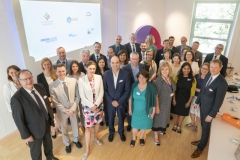EU and Industry Counting on Sustainable Chemistry
CO2 is replacing petroleum as a source for carbon in a joint effort to make the chemical industry more sustainable
Non-fossil energy sources and raw materials for chemical products are becoming more and more feasible. Thanks to intensive research by public and private laboratories, CO2 is replacing petroleum as a source for carbon in a joint effort to make the chemical industry more sustainable.
 The European Chemical Industry Council had invited a delegation of the Council of the EU led by Bulgaria to see for themselves and visit the CAT catalysis research center in Aachen. This organization is run by RWTH Aachen University and materials manufacturer Covestro. Various EU-subsidized research projects at the center are strengthening Europe’s position in the global competition for innovation leadership in CO2 utilization.
The European Chemical Industry Council had invited a delegation of the Council of the EU led by Bulgaria to see for themselves and visit the CAT catalysis research center in Aachen. This organization is run by RWTH Aachen University and materials manufacturer Covestro. Various EU-subsidized research projects at the center are strengthening Europe’s position in the global competition for innovation leadership in CO2 utilization.
Innovation requires good conditions
“We have to support and expand the innovative capacity of European research institutions and businesses in the long run in order to ensure a leading position in the global competition,” Kalin Tomov, Head of Competitiveness Section at the Permanent Representation of Bulgaria to the EU, emphasized. The EU is currently working on a new research and innovation program called “Horizon Europe.” Its focus lies on strengthening Europe as an important place of research and promoting open collaboration between scientists and industrial enterprises. During the Bulgarian Presidency of the Council of the EU, Member States were committed to optimize the circulation and access to research results for the benefit of society and industry.
“The basic conditions within Europe are crucial to achieving the scientific results we need to deliver in order to tap into new resources. I am convinced that for this purpose, science, industry, and the European Union should work together more closely in the future,” Professor Walter Leitner, Chair of Technical Chemistry at RWTH and Director at Max Planck Institute for Chemical Energy Conversion, argued.
Research funding leads to sustainable products
The EU delegation was particularly interested in how carbon extracted from CO2 is already being used for sustainable product manufacturing. One major achievement of RWTH and Covestro is the introduction of a CO2-based material for mattresses.“ We have shown that together with universities, we can unlock and tap into regenerative resources,” Dr. Hermann Bach, head of innovation management at Covestro explains. “But there is still a lot to do. To restructure the entire industry’s resources, we need continued support from the European Union. That is the only way to work together across multiple industry sectors and universities.”
One such example is the pan-European Carbon4PUR project: It investigates how industrial flue gas can be used to produce sustainable plastics through various steps. RWTH and Covestro are two of 14 partners of this EU-subsidized project.
Source: Bioplastics MAGAZINE, 2018-07-02.
